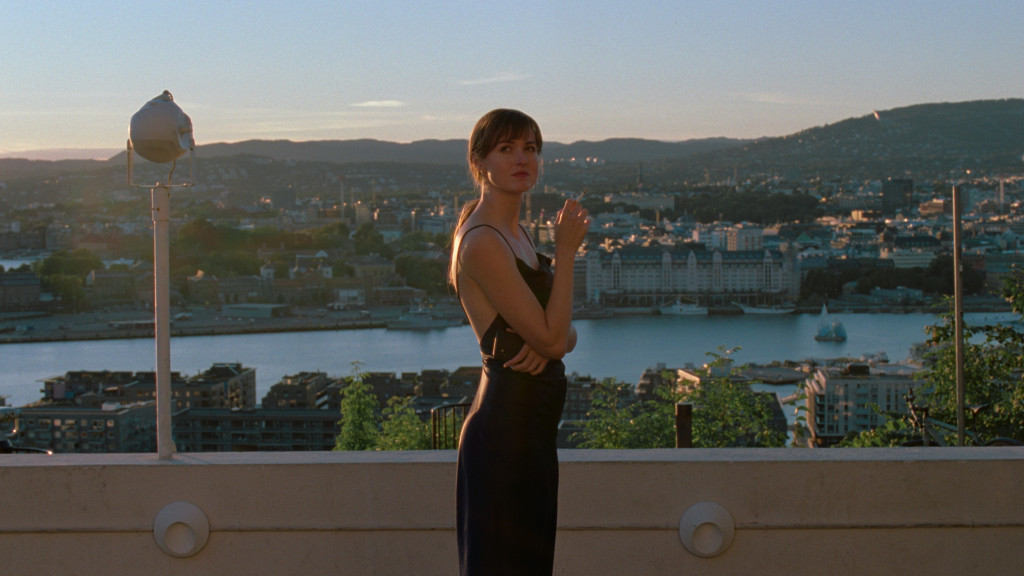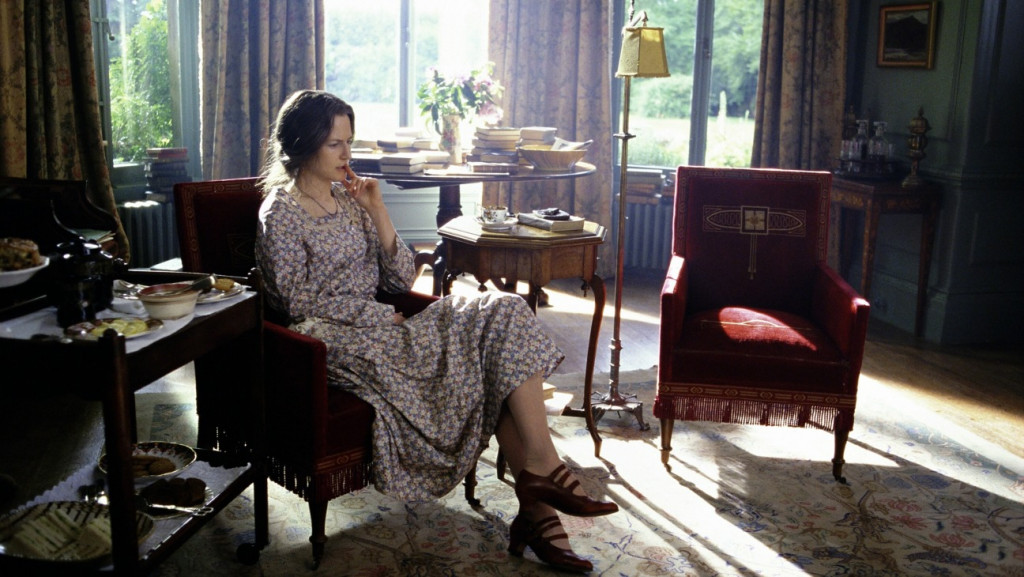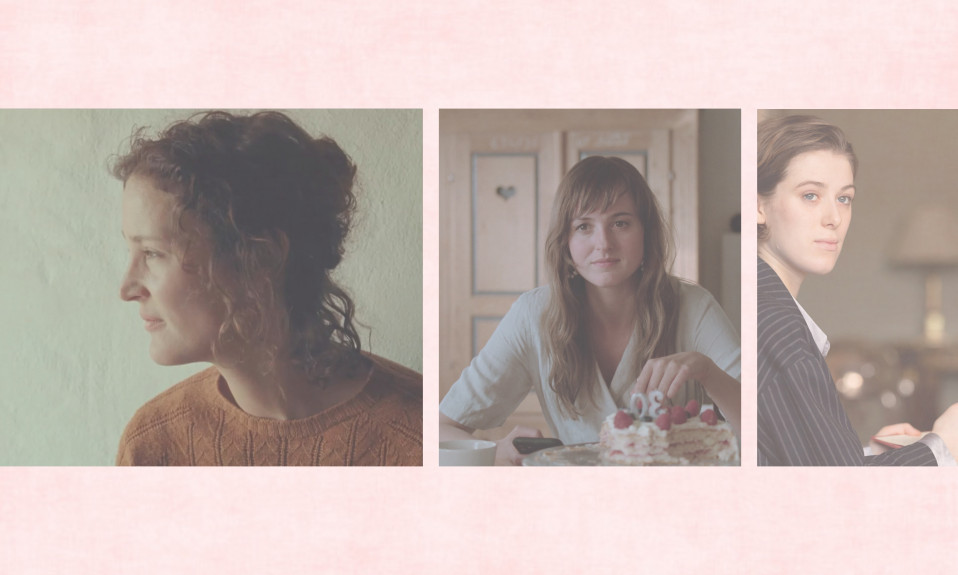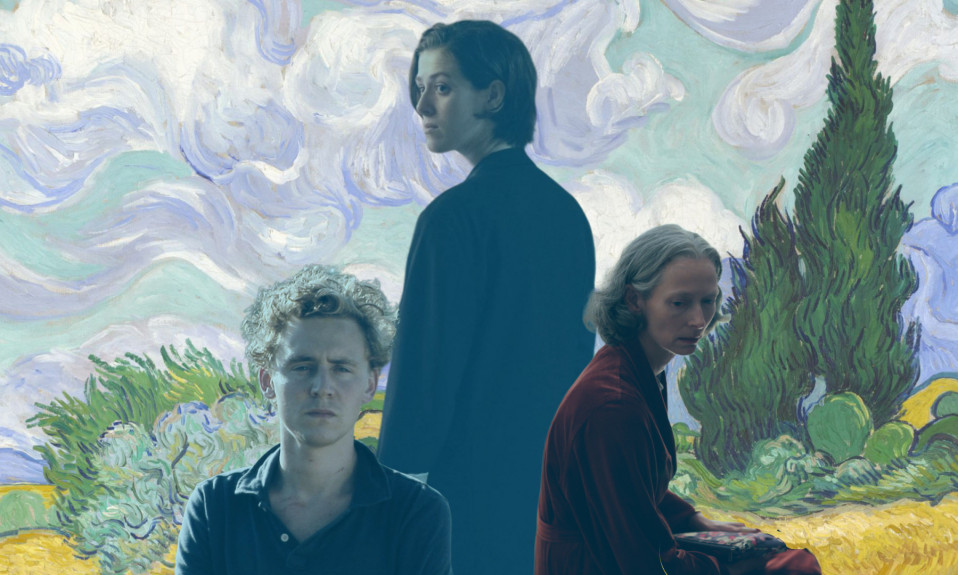A third of the way through Joachim Trier’s The Worst Person in the World, a woman stops time. Julie (Renate Reinsve) is a twenty-something woman looking for something to focus her and help her figure out what she wants from the world. She has fallen into a relationship with an older man, Aksel (Anders Danielsen Lie), a successful cartoonist ready to start a family. As Julie stands in the apartment she shares with her boyfriend, she flicks a switch and the coffee Aksel is pouring for her stops in mid-air. He is frozen too. Julie takes the chance to escape and runs from the apartment, passing an old statuesque woman on the stairs, and then, out on the street, she winds through joggers paused mid-run and cars standing still in the centre of junctions. The only other person who hasn’t stopped is Eivand (Herbert Nordrum), a barista Julie met at a party a few nights previously, who, despite temptation, she decided not to cheat with.
In Julie’s fantasy, the world around her reflects the life she is living. Her relationship with Aksel is nice but safe, and beginning to settle. She spends her weekends in the country with his friends and finds herself awkwardly out of place at artsy parties at which he is the centre of attention. She feels stuck. When she flicks the switch, the stagnant nature of her life is made real and Eivand, who offers the possibility of escape, is the only one not affected. In many ways, the two men, writes Vikram Murthi for The Nation, “represent the classic divide between stability and unpredictability, comfort and risk.” In one’s transition into adulthood, the idea of risk becomes less acceptable. We should all want stability. Yet, with Eivand, Julie wanders through the frozen world, talking and laughing, unaffected by whatever it is that weighs her down. Soon the sun starts to set on the fantasy and it has to end. Julie returns to Aksel, hits the switch again and the world comes back to life. She immediately tells him she doesn’t love him, and that she needs to leave. She takes a risk.

When I saw The Worst Person in the World back in February, I was blown away by it. Not just by this scene, which I felt envious of, but by the way the film encapsulates how it feels to be stuck. In many of the conversations I was having, I’d wanted to stop time, to get up and leave when things grew stale. Conversations from a few years ago began to reemerge, and it felt as if there was nothing new to say. I was still thinking about the same people and still considering the same emotional entanglements I’d been ruminating on for what felt like forever. At the same time, a new life was forcing its way in like blunt trauma to the head. So many conversations revolved around money, around salaries, around job security, around contracts, around marriage, around dating, around children, around engagements, around stability, around property, around the things we had chosen. As I listened to people talk about the lives they were building, I felt drawn to something the Belgian filmmaker Chantal Akerman wrote in her experimental memoir My Mother Laughs: “It’s hard to see why I’ve remained an old child in black and white,” she wrote, and wonders if that elongated childhood, in which she never really grew into the kind of adult she now sees around her, is the “reason never knew how to make a life for .”
I’d done some of the things my friends had. I’d made decisions they’d made, too, but I didn’t feel as happy with them. As time progressed, I wondered about the life I once thought I would live. It was one in which I wasn’t tethered to anything, where I would move from one place to another whenever I needed to. I never imagined a life where I owned property or one that meant I would stay in the town I was born in. Suddenly, it seemed like the life I had built was standing on shaky foundations, and all I could do was think back to the person I used to be and wonder where he went.
Chris (Vicky Krieps) in Mia Hansen-Love’s Bergman Island returns to a previous version of herself, too. She has gone with her filmmaker husband, Tony (Tim Roth) to Fårö, an island in Sweden where the director Ingmar Bergman lived. Chris is working on a new screenplay that explores what happens when lost love returns, while Tony is engaged in Bergman Week, an annual celebration of the filmmaker. Hansen-Love allows us into Chris’s mind as she takes a walk with Tony one afternoon and explains, in detail, her story idea. Then we see it play out; a movie-within-a-movie. It features a young American woman, Amy (Mia Wasikowska), who attends the wedding of an old friend on the island. Her ex-boyfriend, Joseph (Anders Danielsen Lie, again!) is at the wedding too, and Amy has long felt their relationship unresolved. At first, the two take a flirtatious pleasure in pretending they don’t know each other. But as the weekend progresses, they are drawn back into their old passions.

Tony is reluctant to hear about Chris’s current project because it isn’t totally fiction. Amy is a version of Chris, and Joseph a version of her ex. She has been mulling over this story in her time alone on the island, dissatisfied with her own role in life. Chris, like Julie with Aksel, plays second-fiddle to Tony. She waits around for his screenings to finish, wanders about the island while he is wined and dined by the festival organisers, and when she does attend dinner with them, she engages in a discussion about whether it’s easier for men to make art, citing Bergman as an example. The director fathered nine children but wasn’t overly involved in their lives. How could he be if he wanted to make movies?
The stark contrast brings to mind Rebecca Solnit’s essay on Virginia Woolf. After giving a lecture on the writer’s revered body of work, Solnit was asked by an audience member whether Woolf should have had children. “What I should have said to that crowd,” Solnit writes, “was that our interrogation of Woolf’s reproductive status was a soporific and pointless detour from the magnificent questions her work poses.” Woolf considered having children but decided against it and, in questioning her decision, in asking why she did not do what was expected of her, it created a conflict between art and life. What would we rather have, Solnit asks, descendants of Virginia Woolf or To the Lighthouse?
That Woolf felt stuck is interesting, too. In Stephen Daldry’s The Hours, we see Woolf’s final years dramatised. Virginia (Nicole Kidman) is trapped in Richmond, unable to go into London after a series of breakdowns have left her fragile. She tries to escape to the city, but is stopped at the train station by her husband, Leonard (Stephen Dillane). He tells Virginia he is only trying to help her, that it was the city that made her sick and their move to the country was intended to save her life. “My life has been stolen from me,” she tells her husband. “I’m living in a town I have no wish to live in. I’m living a life I have no wish to live. How did this happen?”

How it happened seems to be crucial. When I suddenly realised the type of life I was living wasn’t the one I wanted, it required a retroactive examination of my past choices, a forensic look at all the decisions that led to where I was. So often, life barrels along without anyone noticing, to the point that its almost cliché to say you woke up one day and everything seemed stark and wrong. Once, this type of talk was relegated to the classic mid-life crisis: a time of expensive sports cars, spray tans and taking up with younger lovers. Now, the quarter-life crisis, Juliana Piskorz wrote in 2018, “manifests itself in wanting to run away; to start again, or bury in anything that will distract from own reality.”
In an essay for W magazine, Caitlin Quinlan suggested The Worst Person in the World, along with Joanna Hogg’s The Souvenir: Part II and Paul Thomas Anderson’s Licorice Pizza, was ushering in a new take on the “coming-of-age-film”. For the women at the centre of these movies, their twenties “mark a time of great change and panic”. In “approaching the so-called end of youth” these protagonists “navigate an anxious post-adolescent period that offers new freedoms alongside many of the same fears.” Ultimately, they’re riddled with questions of identity, and whether or not it’s too late to figure out who they are.
All of these films chronicle the struggle but are less interested in the afterwards. In The Worst Person in the World, Julie might have found a career that works for her. In The Souvenir: Part II and Licorice Pizza, the protagonists are on a new path by the film’s close. The end of Bergman Island, however, shows us that Chris got through her state of panic. In the final sections of the film, it’s revealed that the film-within-a-film we’ve been watching, which we believed to be simply a manifestation of Chris’s imagination, is actually the film she has gone on to make. She calls cut and the characters become actors; the world of that story is deconstructed. Chris has not only worked through feeling stuck, but has progressed far enough to turn it into art.
At the centre of feeling stuck is the idea that things are immovable, that change is not as possible as people say. When a life has been built over years and the allocated time for “fun” is over, what is left? To wade back into the uncertain waters navigated in your twenties can feel terrifying. They were hard enough the first time around. To announce that where you’ve ended up is not where you want to be is not easy, but what is the alternative?
Also Read: How Film Changed Me: On Euphoria













1 Comment
Comments are closed.